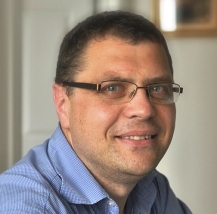Daniel Irimia, MD, PhD
Contact
Center for Engineering in Medicine & Surgery
51 Blossom St.
Boston,
MA
02114
Phone: 617-726-3474
Fax: 617-573-9471
Email: dirimia@mgh.harvard.edu
Daniel Irimia, MD, PhD
- Professor of Surgery, Harvard Medical School
- Associate Bioengineer, Massachusetts General Hospital
- Deputy Director, BioMEMS Resource Center
About Dr. Irimia

Brief Biography
Daniel Irimia, MD, PhD, is an Associate Professor and Deputy Director of the BioMEMS Resource Center at the Center for Engineering in Medicine & Surgery (CEMS). He is an internationally recognized expert in bioengineered microsystems for cellular chemotaxis and other functional assays.
Dr. Irimia’s scholarship is reflected in more than 100 publications, of which more than 60 in the past 5 years. He is senior author on publications in leading journals, including Nature Biomedical Engineering, Nature Materials, Nature Communications, and PNAS.
He is co-author on publications that employ novel microfluidic devices towards biology discoveries, published in journals like Science, Nature Medicine, Science Translational Medicine, Cell Host and Microbe. These publications have been cited more than 5,000 times.
Dr. Irimia is the organizer of the Cell World Races, aimed at encouraging scientists and clinician-researchers to utilize microfluidic tools in their research for higher level of precision and detail that are not currently possible using any of the other tools.
This unorthodox approach increases the awareness for the technological changes taking place in the field of cell motility and has been recently featured on the front page of Wall Street Journal (March 2014) , and covered in news articles in Nature. In 2012, Dr. Irimia was one of the winners of the Wellcome Image Awards for the depiction of “Cancer cells in motion.” In 2016, he was awarded the "Pioneers of Miniaturization" prize from the Chemical and Biological Microsystems Society for his work on microfluidic devices for studying neutrophils and other leukocytes.
Research Summary
Dr. Irimia is a bioengineer trained as a physician and passionate about understanding the clinical consequences of neutrophil activities during disease. His research is focused on designing sophisticated tools to measure relevant neutrophil behavior with the highest precision.
For example, he designs microfluidic devices to measure neutrophil speed and directionality with the highest accuracy among all current techniques. These tools enable us to define a precise range of normal values for neutrophil migration speed in healthy individuals and uncover significant changes after burn injuries.
Recently, Dr. Irimia and his team uncovered a new phenotype of spontaneous neutrophil migration that has predictive value in sepsis. The spontaneous neutrophil migration is a unique phenotype, observed one or two days before the diagnosis of sepsis is confirmed by microbiology, and not encountered in healthy individuals or patients with burns in the absence of sepsis.
Starting from the feedback of the users of our technologies in the clinic, we invented devices that could measure neutrophils migration directly from one droplet of blood, without the need for preliminary separation of neutrophils.
Dr. Irimia is now leading a team of scientists and doctors that employ these devices and novel measurements of neutrophil functions to monitor burn patients, optimize treatments, and uncover neutrophil-targeting interventions that could prevent infections and sepsis in burn patients.
He is also interested in the motility of other cells, including epithelial during wound healing and cancer cells during invasion and metastases and designing new tools for the study of these cells.
Research Thrusts
- Biopreservation
- Burns Trauma and Wound Healing
- Cell Migration in Disease
- Cell Sorting and Cancer Diagnosis
- Global Health
- BioMEMs and Nanoscale Engineering
- Neuroscience and Behavior
Publications
Center for Engineering in Medicine & Surgery
A place where scientific rigor and creativity are matched by a sense of community, the Center for Engineering in Medicine & Surgery is a relatively young and vibrant enterprise that draws strength from its diversity and collective spirit, and from its affiliations with surrounding biomedical research institutions, including Massachusetts General Hospital, the Shriners Hospitals for Children and the Massachusetts Institute of Technology.


